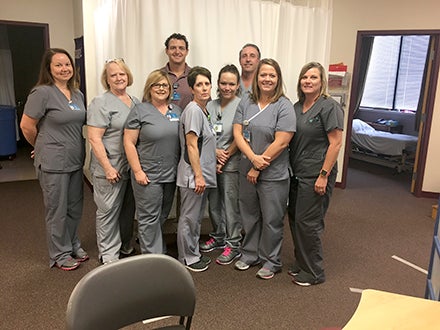Memorial Hospital and Manor physical therapists offer full range of rehab treatments
Published 4:12 pm Friday, August 10, 2018
Step into the Rehabilitation Department of Memorial Hospital and Manor and experience the many different ways they have to assist patients with physical therapy and occupational therapy.
The outpatient clinic located in the Medical Office Building on Wheat Street is probably the most familiar to the general public, while the department in the hospital works with patients who have been admitted. They may be in swing bed care, acute cases or temporary residents of the Manor to receive their rehabilitation following illness or injuries, then go home.
A staff of licensed therapists cover both locations. Paula Adams, PT,DPT serves as the director over all divisions. Daryl Hall, DPT, is a senior therapist at the outpatient clinic.
“When a patient first comes for therapy they must go through a process of testing and assessment to gauge the amount of their pain, see how they walk and how their balance is,” explains Adams.
They serve both children and adults, including babies. Kristin Hudgins, MHS,OTR/L is over the occupational therapy division. She also sees children after school. In May she worked with a baby as young as five days old. It was noticed that the baby was barely moving its left arm. “After therapy the arm is now functioning properly,” she explains.
The Occupational Therapy department works with patients where the goal is to get the patient back to the normal activities of their lives, be it a job or just helping them do the things they need and want to do.
Hudgins and her team demonstrated a couple of the tools they use to test for strength and motor skills. One was called a dynamometer – a grip strength tester. The other was a row of screws stuck face up in a board. The patient must fit the nuts to them. That tests the fine motor skills and dexterity of the patient.
Physical therapy’s aim is to reduce pain and increase muscle strength by working with those who have had bone and/or muscle surgery. It also deals with people who have had heart attacks or those with COPD. It is a matter of reconditioning the patient to help them get stronger and feel better.
Daryl Hall was working with a patient who had recently had total knee replacement. The goal is to increase the range of motion the patient has with the knee and movement of the leg. Hall said he once had a knee replacement patient whose degree of movement went from 80 degrees to 130 degrees in a four-week period of therapy consisting of sessions two to three times a week. He explained that most people reach a plateau in a range of 110 or 120 degrees.
Hall then shared a story of a baby who was brought in for care at 21 months of age because she hadn’t begun to crawl. “Six months later she was not only crawling, but walking,” he says with a smile.
They definitely deal with a large field of ailments and complaints. One of the therapists, Joleen Smith, who suffers from plantar fasciitis, was receiving a treatment from an Iontophoresis machine, a device that delivers medication to her foot through an electrical charge.
All of the therapists show their love for their jobs. There is great satisfaction in helping others and watching their progress. Jamie Williams, PTA, who works mostly in the hospital area summed it up saying, “It is a bonus when you see people get better.”
Outpatient services are provided five full days per week, from 7 a.m. to 5 p.m. as needed. It is necessary to obtain a referral from a physician in order to receive services.






